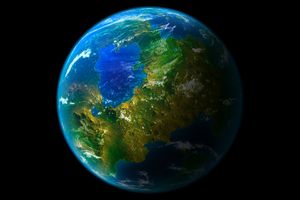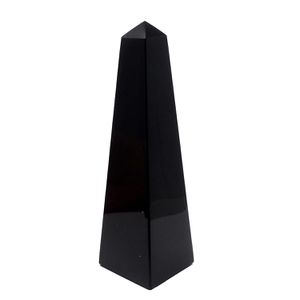

| Class: | M |
| Distance: | 33.10 AU |
| Period: | 36.74 Years |
| Radius: | 6,379.76 km (Similar to Earth) |
| Gravity: | 1.06 G |
- Rotational Period
- 24.03 Hours
- Map
- Map of Soteria
- Minister
- Asmen Vabar (Male, Betezoid)
This is a nearly idyllic world for humans. There is no intelligent life native to the planet, but many known species of plant and animal life are found there. The planets atmosphere is nearly identical to Earth, but a bit richer in Oxygen content. The planet's core is composed similarly to Earth but has an extremely large content of neodymium and piezoelectric crystal formations throughout he mantle. The end result is an unusually strong electromagnetic field, analysis indicates that the crystal formations intensify the magnetic properties of the core by providing a low level electric current through iron formations in the core and mantle. Strong concentrations of neodymium also contribute to the strong magnetic field. This field provides extra protection and shielding from the harmful radiation of the parent star, Schatten allowing the planet to thrive in conditions many others would not.
Unusual Properties
The planet shows some other unusual properties, namely the presence of byproducts of protomatter being found throughout the ecosystem. These byproducts are now inert and pose no threat to life but it does indicate the protomatter was somehow present or involved in the planets formation. This also fits with geological surveys which place the planets age as being somewhere in the 2 thousand years old age, which is far too young to have developed the forms of life present on the planet. It is possible the planet could be the result of a Genesis Device having been used to create it in its current state.
Other Facilities
The Nysa Facility was built on the planet surface to facilitate study of the planet as well as provide support for the Blazing Umbra Station, however, it was destroyed to prevent a Borg invasion. Later the orbiting space station was also destroyed due to a catastrophic containment failure in the temporal core. The crater left by the destruction of Nysa is being left as a memorial to those lost. The current support facility on the planet is Nimbus Station an Atlantis Class City-Ship. In orbit is Serenity Station which mostly manages import/export for the planet as well as some refueling/resupplying facilities and immigration facilities.
Admiral Lance Thomas also used drones to excavate a hide-away for himself at the top of Nabu Summit. It serves as his place to meditate, it has enough room at the top for 2 runabout-sized ships to land, but has no forms of technology. It only has simple fire pit surrounded by stone benches and small shelter made out of stone which has its own fire pit in the center. A supply of wood and other such things is also kept inside the simple shelter.
Obelisk
A 27 meter tall solid obsidian obelisk with inlaid characters believed to depict 5 distinct writing forms either from the same language or different languages. There are approximately 60,000 characters of writing total. The writing is inlaid in different precious metals such as gold, silver, platinum, palladium, and rhodium. Each character style carving is filled with a different metal. The only word that seems readable is the name "Soteria" which appears in the only identified language, that of an ancient proto-cuneiform seen only very rarely on Earth. As this was the only identifiable writing on the planet, it was designated as the planet's name. The purpose, language, and age of the obelisk are all unknown. The entire monument is covered in a carbon covalent network crystal lattice very similar to diamond over a thin layer of glass. The bulk of the mass comes from a unique form of corundum which has iridescent properties due to a highly unusual crystal lattice which is almost certainly artificial. The stone appears black and depending on the specific angle from which light is reflected can appear dark shades of red, blue, and even lighter shades such as orange. The base of the structure is rooted another 11 meters down, scans indicate it ties directly into a naturally occurring vein of granite.
Full Text
Here lies the essence of a civilization that once danced with the stars, driven by dreams as vast as the cosmos itself. In the face of calamity's shadow, our true strength emerged, not from the creations of stone or steel, but from our unyielding will to persevere. This obelisk stands not solely as a marker of our past but as a beacon for future possibilities, a testament to life's resilience, reborn from the ashes of what once was. Let it be known to those who wander these lands, that we, the architects of our destiny, embraced this world as our home. Our journey, woven with trials, concluded not in turmoil but in a whispering breeze, leaving behind a message etched in the silence of our departure: to cherish each fleeting moment as the very fabric of existence. This monument serves as a solemn remembrance of our journey and as a guiding light for those who aspire to continue the legacy we leave behind. To the seekers of knowledge and the stewards of new worlds, may this obelisk mark the dawn of rejuvenation, a cradle for life nurtured by the enduring lessons of our history. Our civilization's final narrative is carved not with the sorrow of our end, but with the hopeful promise that new guardians will emerge to honor and safeguard this rebirth. Explore, learn, and revere the perpetual cycle of renewal that governs the cosmos.
Wanderer
| Class: | D2 |
| Distance: | 3.65 x 105 km |
| Period: | 29.2 Days |
| Radius: | 1848.2 km |
| Gravity: | 0.21 G |
Much like Earth's own moon, this is a spheroid rock composed mostly of ice, frozen hydrocarbons, and a substantial core of iron ore. It does have an unusually strong magnetic field created by the iron ore interacting with the magnetic field of Soteria. The iron core also gives the moon more gravity than one would expect from a Class D satellite.
Mors
| Class: | H2 |
| Distance: | 2.91 x 105 km |
| Period: | 31.8 Days |
| Radius: | 1623.8 km |
| Gravity: | 0.72 G |
The second moon of Soteria is unusual in almost every way. It has a large and super-dense core mostly of iridium, osmium, and platinum. This gives the moon an incredibly high surface gravity of almost 3/4 of Earth-norm. Crystal structures within the moon are puzzling as they are usually only seen in processed and manufactured alloys using those metals. The core is also remarkably consistent which defies the laws of probability for a naturally occurring satellite. Due to the high gravity the surface retains a breathable oxygen-nitrogen atmosphere, though it is thin and the surface temperatures vary widely from extreme cold when the parent star is blocked by Schatten and extremely hot when in direct sunlight. The moon is equipped with an Hermod Gate called Mors Gate, placed here due to the fact that the moon is the home to the Death Korps of Krieg who are in this reality. The gate is used primarily to map Trans-dimensional worlds, which occasionally causes hostilities for which the DKoK are uniquely qualified to handle. There are also basic open-air landing facilities on the moon.